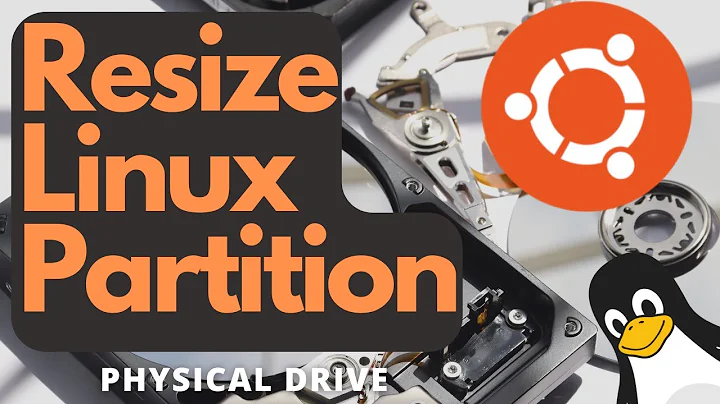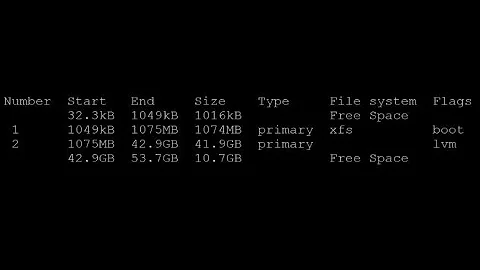how to correctly 'extend' a linux device mapper partition?
How to extend the LVM
cfdisk /dev/sda # create new partition, using all free space
pvcreate /dev/sdaX # initialize partition for use with LVM
vgdisplay # to find VG name
vgextend /dev/vgname /dev/sdaX # this extends the volume group
lvextend -l +100%FREE /dev/vgname/root # this extends the LVM
resize2fs /dev/vgname/root # this extends the filesystem
Explanation of LVM
LVM doesn't care about partitions. A LVM has the following hierachy:
- Filesystem
- Logical Volumes
- Volume Groups
- Physical Volumes
- (Partitions)
- Hardware
Lets go from the bottom up.
At the bottom you have the hardware. Big surprise. On top of that you have PVs. Now here is where it becomes confusing. You can either have a PV be the drive itself or a partition. LVM does not need partitions. You can add raw block devices as PVs. However, many people create partitions anyways. There are many reasons for this. Backwards compatibility with tools or people that expect partitions, for example. If a sysadmin does not know the layout and sees an 'empty' disk, he might think the disk is empty, although it is a PV! So thats the reason why you sometimes use partitions as PVs.
This is what you see in your example, whoever set the server up created one partition per VG, apparently.
Next up are the volume groups. A VG is one or multiple PVs. This is the container that holds all the stuff that comes afterwards. Since PVs can be disks, virtual disks from RAID controllers, partitions, etc., VGs can span any number of these things.
On top of VGs you have LVs. This is what you actually put your filesystems on top of. You can look at a LV kind of like a partition. You can find them here:
/dev/VGName/LVname
So a LV always belongs to one VG, but you can have many LVs per VG.
On top of the LV, finally, you put your filesystem.
Why loop
The loop conundrum: there is no loop device! Parted cannot find a partition table on the LVM (as it should be), so it just displays 'loop' instead.
Related videos on Youtube
Sum1sAdmin
Robert is a system administrator who enjoys speaking in the third person, he is quite good at turning me on.
Updated on September 18, 2022Comments
-
Sum1sAdmin almost 2 years
I am missing some concept with linux disk management, I have free space on a single physical volume that I want to to extend an ext4 file-system with, which is a logical volume.
I look at fdisk -l - it is a GPT (warnings)
Disk /dev/sda: 299.4 GB, 299439751168 bytes 255 heads, 63 sectors/track, 36404 cylinders, total 584843264 sectors Units = sectors of 1 * 512 = 512 bytes Sector size (logical/physical): 512 bytes / 512 bytes I/O size (minimum/optimal): 512 bytes / 512 bytes Disk identifier: 0x00000000 Device Boot Start End Blocks Id System /dev/sda1 1 584843263 292421631+ ee GPTI look at the physical volumes:
root@node-29:/home# pvs PV VG Fmt Attr PSize PFree /dev/sda4 os lvm2 a-- 62.00g 4.00m /dev/sda5 logs lvm2 a-- 10.00g 4.00m /dev/sda6 mysql lvm2 a-- 20.00g 4.00m /dev/sda7 narcine lvm2 a-- 11.00g 4.00mthis adds up to 93GB, the is a swap partition and a few others but, I have lots of free space
I look at parted, since they are GPT partitions - I want to see the free space available:
root@node-29:/home# parted /dev/sda print free Model: DELL PERC H710 (scsi) Disk /dev/sda: 299GB Sector size (logical/physical): 512B/512B Partition Table: gpt Number Start End Size File system Name Flags 17.4kB 1049kB 1031kB Free Space 1 1049kB 26.2MB 25.2MB primary bios_grub 26.2MB 27.3MB 1049kB Free Space 2 27.3MB 237MB 210MB primary 237MB 238MB 1049kB Free Space 3 238MB 448MB 210MB ext2 primary 448MB 449MB 1049kB Free Space 4 449MB 67.1GB 66.6GB primary 67.1GB 67.1GB 1049kB Free Space 5 67.1GB 77.9GB 10.8GB primary 77.9GB 77.9GB 1049kB Free Space 6 77.9GB 99.4GB 21.5GB primary 99.4GB 99.4GB 1049kB Free Space 7 99.4GB 111GB 11.9GB primary 111GB 111GB 1049kB Free Space 8 111GB 111GB 21.0MB ext2 primary 111GB 299GB 188GB Free Spacethere's a little free space on all the volumes but there is the space I want on the last line
Number Start End Size File system Name Flags 111GB 299GB 188GB Free SpaceIn LVM I see the devices are in /dev/mapper, I look at dmsetup
root@node-29:/home# dmsetup info Name: narcine-nartemp State: ACTIVE Read Ahead: 256 Tables present: LIVE Open count: 1 Event number: 0 Major, minor: 252, 0 Number of targets: 1 UUID: LVM-eDmr02vsptbjvAdvX9c7VZGuI3drAkuMqYAIwCAy6EEZ2GTAopLlD96o6CmOtszP Name: os-swap State: ACTIVE Read Ahead: 256 Tables present: LIVE Open count: 2 Event number: 0 Major, minor: 252, 4 Number of targets: 1 UUID: LVM-hMIdqpNc1W6paxT044lNpBcPUfWGA2kESL4f6dB9OJu14mKzLvnOzKMeNM6zV4SK Name: os-root State: ACTIVE Read Ahead: 256 Tables present: LIVE Open count: 1 Event number: 0 Major, minor: 252, 3 Number of targets: 1 UUID: LVM-hMIdqpNc1W6paxT044lNpBcPUfWGA2kEcIBDlsTce6uqieEfh6ehzYfLxJwaIoEe Name: mysql-root State: ACTIVE Read Ahead: 256 Tables present: LIVE Open count: 1 Event number: 0 Major, minor: 252, 1 Number of targets: 1 UUID: LVM-rYCHA1YXEPa6jDTS8NIHRvTXllf7jeNhT5d7pulT4efAq4TMll6ndWVuyiDYgGbs Name: logs-log State: ACTIVE Read Ahead: 256 Tables present: LIVE Open count: 1 Event number: 0 Major, minor: 252, 2 Number of targets: 1 UUID: LVM-npxUm7C9dQX7fIrLeAGyfJxrDWKzmb9rVfJS8FEspobIPK8bnuOnDzLNdQtsY4jEhow should I proceed with extending? what is the order (parted, lvm, dmsetup?) - parted tells me the device partition is loop - what does that mean?
Model: Linux device-mapper (linear) (dm) Disk /dev/mapper/os-root: 53.7GB Sector size (logical/physical): 512B/512B Partition Table: loop Number Start End Size File system Flags 1 0.00B 53.7GB 53.7GB ext4 Model: Linux device-mapper (linear) (dm) Disk /dev/mapper/os-swap: 12.9GB Sector size (logical/physical): 512B/512B Partition Table: loop Number Start End Size File system Flags 1 0.00B 12.9GB 12.9GB linux-swap(v1) Model: Linux device-mapper (linear) (dm) Disk /dev/mapper/logs-log: 10.7GB Sector size (logical/physical): 512B/512B Partition Table: loop Number Start End Size File system Flags 1 0.00B 10.7GB 10.7GB ext4 Model: Linux device-mapper (linear) (dm) Disk /dev/mapper/mysql-root: 21.5GB Sector size (logical/physical): 512B/512B Partition Table: loop Number Start End Size File system Flags 1 0.00B 21.5GB 21.5GB ext4 Model: Linux device-mapper (linear) (dm) Disk /dev/mapper/narcine-nartmp: 11.8GB Sector size (logical/physical): 512B/512B Partition Table: loop Number Start End Size File system Flags 1 0.00B 11.8GB 11.8GB xfsI expected
pvsan -vvto show me free PEfree on /dev/sda - why doesn't it?what's throwing me is the command
dmcreateit looks like with this, there is no need to create "traditional" partitions - is that correct?thanks.
-
Sum1sAdmin over 7 yearsthanks mzhaase,I am trying to understand the logical disk layout a bit more, cfdisk won't list the current partitions as they are GPT, I suspect that LVM is creating the device mapper entries (?), but the device mapper commands and the output of parted (above) are confusing - for example fdisk, cfdisk tell me to use parted as the partitions are GPT, and parted lists them as loop devices & linux device mapper model
-
 mzhaase over 7 years@Sum1sAdmin ok, added a short LVM explanation, hope that clears things up.
mzhaase over 7 years@Sum1sAdmin ok, added a short LVM explanation, hope that clears things up. -
Sum1sAdmin over 7 yearsthanks again for your input, I understand lvm - physical, logical, volume groups etc, - but it seems that these volumes are loop devices - such as an ISO would be, LVM can't do that. 'Model: Linux device-mapper (linear) (dm) Disk /dev/mapper/narcine-nartmp: 11.8GB Sector size (logical/physical): 512B/512B Partition Table: loop'
-
 mzhaase over 7 years@Sum1sAdmin Ah, now I understand. The LVM does not have a partition table, hence parted is showing 'loop'. It does that when it cannot find a partition table. See: bugzilla.redhat.com/show_bug.cgi?id=741593
mzhaase over 7 years@Sum1sAdmin Ah, now I understand. The LVM does not have a partition table, hence parted is showing 'loop'. It does that when it cannot find a partition table. See: bugzilla.redhat.com/show_bug.cgi?id=741593 -
Sum1sAdmin over 7 yearsthat's a 5 year old bug report for rhel, I am interested in an answer that explains how these devices where created, why there are loop devices and how to extend (I understand that LVM will be finally used to extend the volume)
-
Tero Kilkanen over 7 yearsPartition table type
loopis the description Parted uses when there is no partition table on a device. And this is the way it should be on Logical Volumes, they simply have filesystems. It does not refer to loop devices in any way. The partition table types (labels) used in Parted are described in gnu.org/software/parted/manual/html_chapter/parted_2.html . Otherwise mzhaase's procedure for the volume extension looks correct. However, performance will not be optimal, because there will be a gap between original and added space. -
 Joshua Huber over 7 yearsAnother really good reason to put your PV on a partition instead of a raw device: you may eventually need to replace disks, especially in an array, and the exact same disk model might not be available in 5 years, manufacturers play number tricks the with meanings of "Giga" and "Tera", so one manufacturer's 3 TB disk might be a few MB larger (or more importantly smaller) than your original. If you partition the disk with a single GPT partition, starting at 1MB and leave 100MB free at end, you'll be aligned for sure and will have a small margin in case a replacement drive is trivially smaller.
Joshua Huber over 7 yearsAnother really good reason to put your PV on a partition instead of a raw device: you may eventually need to replace disks, especially in an array, and the exact same disk model might not be available in 5 years, manufacturers play number tricks the with meanings of "Giga" and "Tera", so one manufacturer's 3 TB disk might be a few MB larger (or more importantly smaller) than your original. If you partition the disk with a single GPT partition, starting at 1MB and leave 100MB free at end, you'll be aligned for sure and will have a small margin in case a replacement drive is trivially smaller. -
 mzhaase over 7 years@Sum1sAdmin as mentioned in that bug report, just because parted is reporting loop devices does not mean there are loop devices. Parted also reports loop when it cannot find a partition table, as is the case with lvm.
mzhaase over 7 years@Sum1sAdmin as mentioned in that bug report, just because parted is reporting loop devices does not mean there are loop devices. Parted also reports loop when it cannot find a partition table, as is the case with lvm. -
Naveed Abbas over 7 years@JoshuaHuber Both your and mzhaase's arguments only apply to physical HDDs, not to vmWare/HyperV/virtual disks. With VM, I don't see any benefit of PV-on-a-partition versus a simple raw PV.
-
 Joshua Huber over 7 years@kubanczyk, one edge case (and I'm really stretching here), is in case of Junior Admin blunder, your virtual disk gets accidentally attached to another VM which happens to be running Windows. If that happens, the Windows user would get a prompt something akin to "hey you just put in an unpartitioned disk.. would you like me to partition & NTFS format it?" If the PV were inside a partition, you could still zap it, but the steps would be more deliberate. (Again, this is a stretch.) I've done similar countermeasures on thumbdrives, a small FAT32 partition up front to deter a Windows snafu.
Joshua Huber over 7 years@kubanczyk, one edge case (and I'm really stretching here), is in case of Junior Admin blunder, your virtual disk gets accidentally attached to another VM which happens to be running Windows. If that happens, the Windows user would get a prompt something akin to "hey you just put in an unpartitioned disk.. would you like me to partition & NTFS format it?" If the PV were inside a partition, you could still zap it, but the steps would be more deliberate. (Again, this is a stretch.) I've done similar countermeasures on thumbdrives, a small FAT32 partition up front to deter a Windows snafu.





